It has been announced today, the HCM 9.1 feature pack 2 comes with Peopletools 8.52 and a lot more new features including “A new search-based, menu-free navigation capability allows users to easily locate and navigate to relevant information quickly and in context from any page”, find out the press release here.
It is not available for download yet on edelivery but that should be a matter of hours.
We could also expect the corresponding Peoplesoft OVM template to be release pretty soon, keep tracking edelivery/linux.
Nicolas.
Thursday, November 10, 2011
Peoplesoft HCM 9.1 Feature Pack 2
GUID on Web domain
I was managing Peoplesoft Web domains in OEM Grid Control (11.1) within the Peoplesoft plugin. After cloning different environments some strange behavior came out.
First, the GUID must be unique across the all the Peoplesoft databases (table PSOPTIONS), otherwise databases are somehow pointing to each other. Before starting with the whole OEM configuration, it’s probably better to set it to blank and restart the Application Server. A new value will be given when Application Server will start.
Then I came to know that a Webserver configuration file also contains the GUID. If it is the wrong one, your Web domain will point to the wrong database… fix it by updating the file $PIA_HOME/webserv/…/domain/webprof/option.prop within the proper GUID value.
Nicolas.
DomainConnectionPwd parameter
A quick note after an issue I was facing to.
On Peopletools 8.51, I cloned an existing database, creating new application server domain and copied an existing web domain. Everything went fine, I could connect onto the front-end application and work… until I bounced the application server. On the Peoplesoft login page, an error was returned complaining that application server was down at that time… where it was obviously up and running.
Checking the application server log file reveals the following :
"ERROR: Jolt client (ip address <ip_address_is_given_here>) does not have proper application password"
After few minutes, solution came in the top of my head. A new parameter introduced in 8.50, DomainConnectionPwd, should match between configuration files of application server (psappsrv.cfg) and web server (configuration.properties).
Once fixed and bounced application server, it worked again. But I just wondering why and how it worked in a first place.
Nicolas.
Thursday, November 03, 2011
Peopletools 8.52 : the PS_APP_HOME variable
Up to Peopletools 8.51, the application installation (e.g. HRMS, FSCM…) must be done in the exact same folder where the Peopletools have been installed, known as PS_HOME directory. Otherwise you were not able to load any data in a newly created database (through the database setup of FataMover, no option was appearing). It was quite confusing, expecially for new comers in the Peoplesoft world.
As of Peopletools 8.52, it has been changed. You can install the application where ever you want, and say to the Peopletools where it is through a new variable PS_APP_HOME. That’s not an environment variable, but rather has to be set within the Configuration Manager.
Let’s have a look.
First you should create a profile for the database you want to load data in : 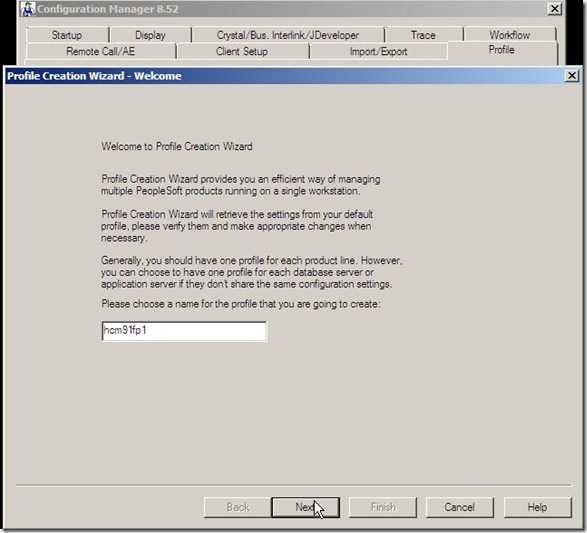
Then you will define it has a “database” (2tier connection) : 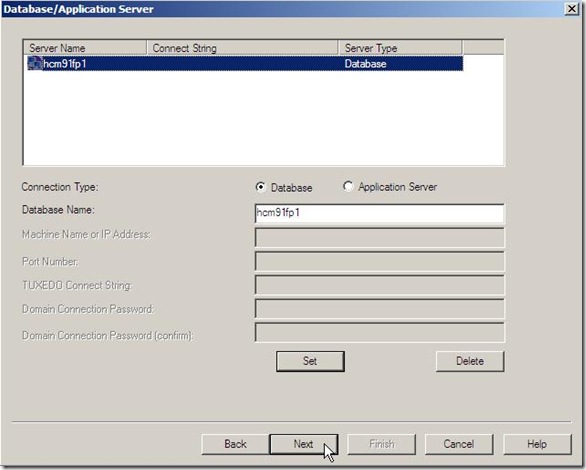
Next window, a new field is there to define where is the application installed : 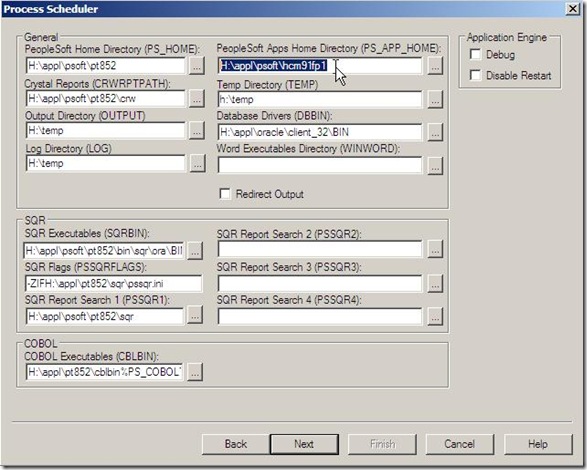
Go till the end of the profile definition.
Now you should be able to see the application in Datamover, database setup : 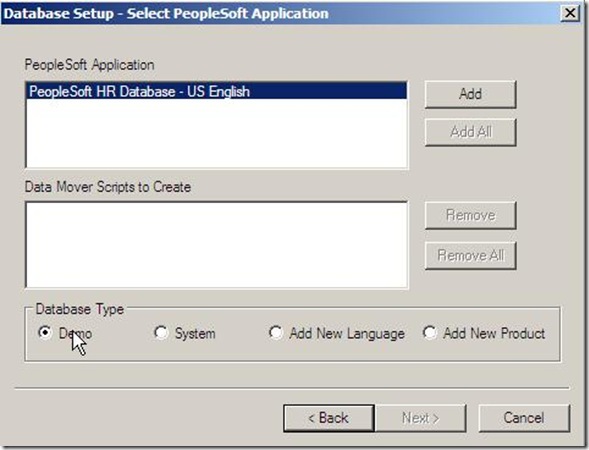
And all the path directories are properly set for the INPUT datafiles in the created dms : 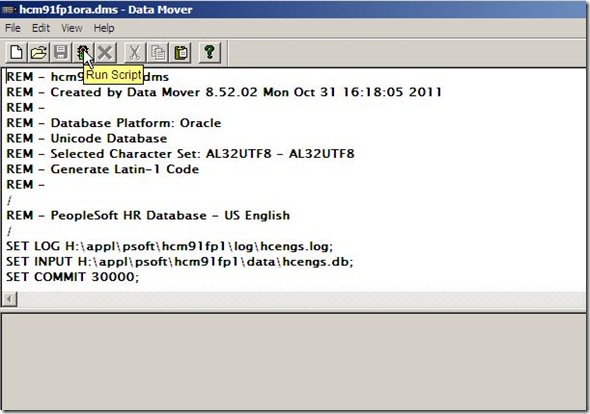
Now we can discuss the exact use of having separate home for Peopletools and Application, it could really be a debate in the organization.
Nicolas.
Tuesday, November 01, 2011
Peopletools 8.52 : managing PIA with psadmin
It can be managed within the command line
[ptools852@orion5 appserv]$ ./psadmin -help
Usage:
Miscellaneous options:
----------------------
psadmin (Interactive utility)
psadmin -h (Display this message)
psadmin -v (Display version number)
psadmin -env (Display environment as set by psadmin)
psadmin -replicate -ch <PS_CFG_HOME>
Pure Internet Architecture (PIA) Options:
-----------------------------------
psadmin -w command -d domain (Perform command on PIA domain)
where 'command' must be one of the following:
start (Start the domain)
shutdown (Shutdown this domain)
shutdown! (Forced shutdown of this domain)
status (Show status for this domain)
remove (Delete the domain)
psadmin -w configure -d domain -c c_set -p p_set
where 'c_set' specifies domain settings, having the following format:
minHeapSize/maxHeapSize/maxThreads/authTokenDomain
and 'p_set' specifies port settings, having the following format:
httpPort/httpsPort
psadmin -w configure -d domain -s site -c c_set
where 'c_set' specifies site settings, having the following format:
appSrvConnString/webProfile/pooling/reportPath/webProfUser/webProfPword/appSrvConnPword
<…snipped…>
Or within the menu
[ptools852@orion5 appserv]$ env|grep PIA_HOME
PIA_HOME=/appl/psoft/hcm91fp1_web
[ptools852@orion5 appserv]$ env|grep CFG_HOME
PS_CFG_HOME=/appl/psoft/hcm91fp1_dom
[ptools852@orion5 appserv]$ ./psadmin
PSADMIN -- Tools Release: 8.52.02
Copyright (c) 1996, 2011, Oracle. All rights reserved.
--------------------------------
PeopleSoft Server Administration
--------------------------------
Config Home: /appl/psoft/hcm91fp1_dom
1) Application Server
2) Process Scheduler
3) Search Server
4) Web (PIA) Server
5) Switch Config Home
6) Replicate Config Home
q) Quit
Command to execute (1-6, q): 4
-----------------------------
PeopleSoft PIA Administration
-----------------------------
PIA Home: /appl/psoft/hcm91fp1_web
1) Administer a domain
2) Create a domain
3) Delete a domain
q) Quit
Command to execute:
=> Let’s create a new web domain for my new Peopletools 8.52 installation.
[ptools852@orion5 appserv]$ ./psadmin
PSADMIN -- Tools Release: 8.52.02
Copyright (c) 1996, 2011, Oracle. All rights reserved.
--------------------------------
PeopleSoft Server Administration
--------------------------------
Config Home: /appl/psoft/hcm91fp1_dom
1) Application Server
2) Process Scheduler
3) Search Server
4) Web (PIA) Server
5) Switch Config Home
6) Replicate Config Home
q) Quit
Command to execute (1-6, q): 4
-----------------------------
PeopleSoft PIA Administration
-----------------------------
PIA Home: /appl/psoft/hcm91fp1_web
1) Administer a domain
2) Create a domain
3) Delete a domain
q) Quit
Command to execute: 2
---------------------------------------------
PeopleSoft PIA Administration - Create Domain
---------------------------------------------
PIA Home: /appl/psoft/hcm91fp1_web
1) Create a domain
2) Replicate a domain
q) Quit
Command to execute: 1
---------------------------------------------
PeopleSoft PIA Administration - Create Domain
---------------------------------------------
PIA Home: /appl/psoft/hcm91fp1_web
1) Domain name :[peoplesoft]
2) Web server :[weblogic]
3) Web server root directory :[/opt/oracle]
4) Web server login id :[system]
5) Web server password :[Passw0rd]
6) Website name :[ps]
7) Application server :[orion5.phoenix.nga]
8) JSL Port :[9000]
9) HTTP Port :[80]
10) HTTPS Port :[443]
11) Authentication Token Domain :[]
12) Web profile :[PROD]
13) Web profile user id :[PTWEBSERVER]
14) Web profile password :[PTWEBSERVER]
15) PeopleSoft reports directory :[/appl/psoft/hcm91fp1_web]
c) Create the domain as shown
q) Quit
Command to execute:
---------------------------------------
PeopleSoft PIA Administration - Create Domain
---------------------------------------------
PIA Home: /appl/psoft/hcm91fp1_web
1) Domain name :[peoplesoft]
2) Web server :[weblogic]
3) Web server root directory :[/appl/mdlware/weblogic]
4) Web server login id :[system]
5) Web server password :[Passw0rd]
6) Website name :[hcm91fp1]
7) Application server :[orion5.phoenix.nga]
8) JSL Port :[9000]
9) HTTP Port :[8000]
10) HTTPS Port :[8443]
11) Authentication Token Domain :[]
12) Web profile :[DEV]
13) Web profile user id :[PTWEBSERVER]
14) Web profile password :[PTWEBSERVER]
15) PeopleSoft reports directory :[/appl/psoft/hcm91fp1_web/reports/hcm91fp1]
c) Create the domain as shown
q) Quit
Command to execute: c
Creating the domain. This may take several minutes, please be patient.
..............................................................
The domain has been created
-----------------------------
PeopleSoft PIA Administration
-----------------------------
PIA Home: /appl/psoft/hcm91fp1_web
1) Administer a domain
2) Create a domain
3) Delete a domain
q) Quit
Command to execute: 1
------------------------------------------------------
PeopleSoft PIA Domain Administration - Choose a Domain
------------------------------------------------------
1) peoplesoft
q) Quit
Command to execute: 1
------------------------------------
PeopleSoft PIA Domain Administration
------------------------------------
PIA Home: /appl/psoft/hcm91fp1_web
PIA Domain: peoplesoft
1) Boot this domain
2) Shutdown this domain
3) Get the status of this domain
4) Configure this domain
5) Edit configuration files
6) View log files
7) Administer a site
8) Delete a site
q) Quit
Command to execute: 1
Starting the domain.....
Server state changed to STARTING..............
Server state changed to STANDBY.
Server state changed to STARTING.............
Server state changed to ADMIN.
Server state changed to RESUMING.
Server state changed to RUNNING.
Verifying domain status......
The domain has started.
Now, I’m a bit struggled with the variable PIA_HOME, it appears not working afterwards until and unless I set PS_CFG_HOME=$PIA_HOME. Or maybe I did not understood very well that variable usage.
Anyway, with command line everything become much simpler than ever to start the entire street :
[ptools852@orion5 ~]$ cd $PS_HOME/appserv
[ptools852@orion5 appserv]$ env|grep PIA_HOME
PIA_HOME=/appl/psoft/hcm91fp1_web
[ptools852@orion5 appserv]$ env|grep PS_CFG_HOME
PS_CFG_HOME=/appl/psoft/hcm91fp1_dom
[ptools852@orion5 appserv]$ ./psadmin -c boot -d hcm91fp1
Attempting to boot bulletin board...
tmadmin - Copyright (c) 2007-2008 Oracle.
Portions * Copyright 1986-1997 RSA Data Security, Inc.
All Rights Reserved.
Distributed under license by Oracle.
Tuxedo is a registered trademark.
No bulletin board exists. Entering boot mode.
> INFO: Oracle Tuxedo, Version 10.3.0.0, 64-bit, Patch Level 071
Booting admin processes ...
exec BBL -A :
process id=24244 ... Started.
1 process started.
Attaching to active bulletin board.
> Attempting to boot ...
INFO: Oracle Tuxedo, Version 10.3.0.0, 64-bit, Patch Level 071
Booting server processes ...
exec PSWATCHSRV -o ./LOGS/stdout -e ./LOGS/stderr -A -- -ID 200223 -D hcm91fp1 -S PSWATCHSRV :
process id=24248 ... Started.
exec PSAPPSRV -o ./LOGS/stdout -e ./LOGS/stderr -s@psappsrv.lst -- -D hcm91fp1 -S PSAPPSRV :
process id=24249 ... Started.
<…snipped…>
exec JSL -o ./LOGS/stdout -e ./LOGS/stderr -A -- -n //orion5.phoenix.nga:9000 -m 9 -M 12 -I 5 -j ANY -x 40 -S 10 -c 1000000 -w JSH :
process id=24374 ... Started.
exec JREPSVR -o ./LOGS/stdout -e ./LOGS/stderr -A -- -W -P /appl/psoft/hcm91fp1_dom/appserv/hcm91fp1/jrepository :
process id=24384 ... Started.
15 processes started.
[ptools852@orion5 appserv]$ ./psadmin -p start -d hcm91fp1
Attempting to boot bulletin board...
tmadmin - Copyright (c) 2007-2008 Oracle.
Portions * Copyright 1986-1997 RSA Data Security, Inc.
All Rights Reserved.
Distributed under license by Oracle.
Tuxedo is a registered trademark.
No bulletin board exists. Entering boot mode.
> INFO: Oracle Tuxedo, Version 10.3.0.0, 64-bit, Patch Level 071
Booting admin processes ...
exec BBL -A :
process id=24391 ... Started.
1 process started.
Attaching to active bulletin board.
> Attempting to boot ...
INFO: Oracle Tuxedo, Version 10.3.0.0, 64-bit, Patch Level 071
Booting server processes ...
exec PSMSTPRC -o ./LOGS/stdout -e ./LOGS/stderr -A -- -CD hcm91fp1 -PS PSUNX -A start -S PSMSTPRC :
process id=24410 ... Started.
exec PSAESRV -o ./LOGS/stdout -e ./LOGS/stderr -- -CD hcm91fp1 -S PSAESRV :
process id=24419 ... Started.
<…snipped…>
exec PSMONITORSRV -o ./LOGS/stdout -e ./LOGS/stderr -A -- -ID 88726 -PS PSUNX -S PSMONITORSRV :
process id=24473 ... Started.
8 processes started.
[ptools852@orion5 appserv]$ ./psadmin -w start -d peoplesoft
Domain Not Found: peoplesoft
[ptools852@orion5 appserv]$ export PS_CFG_HOME=$PIA_HOME
[ptools852@orion5 appserv]$ ./psadmin -w start -d peoplesoft
Starting the domain........
Server state changed to STARTING...........
Server state changed to STANDBY.
Server state changed to STARTING........
Server state changed to ADMIN.
Server state changed to RESUMING.
Server state changed to RUNNING.
Verifying domain status......
The domain has started.
[ptools852@orion5 appserv]$
Same behavior when using the interactive menu of psadmin, once the webserver is created as I showed above, it does not take it in account anymore :
[root@orion5 ~]# su - ptools852
[ptools852@orion5 ~]$ cd $PS_HOME/appserv
[ptools852@orion5 appserv]$ env|grep PIA_HOME
PIA_HOME=/appl/psoft/hcm91fp1_web
[ptools852@orion5 appserv]$ env|grep PS_CFG_HOME
PS_CFG_HOME=/appl/psoft/hcm91fp1_dom
[ptools852@orion5 appserv]$ ./psadmin
PSADMIN -- Tools Release: 8.52.02
Copyright (c) 1996, 2011, Oracle. All rights reserved.
--------------------------------
PeopleSoft Server Administration
--------------------------------
Config Home: /appl/psoft/hcm91fp1_dom
1) Application Server
2) Process Scheduler
3) Search Server
4) Web (PIA) Server
5) Switch Config Home
6) Replicate Config Home
q) Quit
Command to execute (1-6, q): 4
-----------------------------
PeopleSoft PIA Administration
-----------------------------
PIA Home: /appl/psoft/hcm91fp1_dom <—here it is not my predefined $PIA_HOME
1) Administer a domain
2) Create a domain
3) Delete a domain
q) Quit
Command to execute:
Well, from the Peoplebooks, we can read “If you have the PIA_HOME environment variable set, this overrides the use of PS_CFG_HOME for PIA installations.”, that’s fine, it worked as I showed above for install, but does it mean it won’t override PS_CFG_HOME afterwards ? Or preferably, you change PS_CFG_HOME on-line, or before running psadmin to the desired PIA_HOME.
Nicolas.
Peopletools 8.52 : psadmin
There are few interesting changes in the Peopletools 8.52 psadmin menu :
PeopleSoft Server Administration
--------------------------------
Config Home: /appl/psoft/hcm91fp1_dom
1) Application Server
2) Process Scheduler
3) Search Server
4) Web (PIA) Server
5) Switch Config Home
6) Replicate Config Home
q) Quit
Option 4 and 5 have been added compared to the previous Peopletools version.
The option 5 is rather good, be able to change the PS_CFG_HOME on-line without exiting from the program. Managing different home is now greatly simplified :
Command to execute (1-6, q): 5
Please provide new Config Home location or q to quit:
The option 4, managing the PIA within the psadmin is useful if and only if the webserver is hosted on the same server.
[ptools852@orion5 appserv]$ ./psadmin
PSADMIN -- Tools Release: 8.52.02
Copyright (c) 1996, 2011, Oracle. All rights reserved.
--------------------------------
PeopleSoft Server Administration
--------------------------------
Config Home: /appl/psoft/hcm91fp1_dom
1) Application Server
2) Process Scheduler
3) Search Server
4) Web (PIA) Server
5) Switch Config Home
6) Replicate Config Home
q) Quit
Command to execute (1-6, q): 4
-----------------------------
PeopleSoft PIA Administration
-----------------------------
PIA Home: /appl/psoft/hcm91fp1_web
1) Administer a domain
2) Create a domain
3) Delete a domain
Here we can see the output of the PIA_HOME variable, if it is not set in the environment, it is set by default to PS_CFG_HOME (Config Home).
Well, I’m not sure how to quantify the customer having such configuration (Peopletools installed onto the webserver), but as far as I know from the shops I worked for, that’s rather rare. Anyway, I’ll test this option in a coming blog entry.
There’s also some new options in the psadmin command line, PIA management, delete an application domain, find out more within the command “psadmin –help”.
Find out more in the OTN hosted Peoplebooks : http://download.oracle.com/docs/cd/E25688_01/pt852pbr0/eng/psbooks/tsvt/book.htm?File=tsvt/htm/tsvt06.htm#H2001
Now, building a new environment for Peopletools 8.52 on Oracle Linux 6.1 (well, it is not certified yet, but looks to work like a charm), create a new application domain can return the following error :
----------------------------------------------
Quick-configure menu -- domain: hcm91fp1
----------------------------------------------
Features Settings
========== ==========
1) Pub/Sub Servers : No 16) DBNAME :[hcm91fp1]
2) Quick Server : No 17) DBTYPE :[ORACLE]
3) Query Servers : No 18) UserId :[PS]
4) Jolt : Yes 19) UserPswd :[PS]
5) Jolt Relay : No 20) DomainID :[hcm91fp1]
6) WSL : No 21) AddToPATH :[.]
7) PC Debugger : No 22) ConnectID :[people]
8) Event Notification: No 23) ConnectPswd:[peop1e]
9) MCF Servers : No 24) ServerName :[]
10) Perf Collator : No 25) WSL Port :[7000]
11) Analytic Servers : No 26) JSL Port :[9000]
12) Domains Gateway : No 27) JRAD Port :[9100]
Actions
=========
13) Load config as shown
14) Custom configuration
15) Edit environment settings
h) Help for this menu
q) Return to previous menu
Enter selection (1-27, h, or q): 13
Performing load prechecks ...
/appl/psoft/ptools852/bin/ubbgen: error while loading shared libraries: libtux.so: cannot open shared object file: No such file or directory
==============ERROR!================
UBBGEN encountered an error while configuring!
==============ERROR!================
It is nothing but LD_LIBRARY_PATH not set. Adding it in the .bash_profile as below :
[ptools852@orion5 ~]$ more .bash_profile
# .bash_profile
# Get the aliases and functions
if [ -f ~/.bashrc ]; then
. ~/.bashrc
fi
# User specific environment and startup programs
PATH=$PATH:$HOME/bin
export PATH
TUXDIR=/appl/mdlware/tuxedo; export TUXDIR
ORACLE_BASE=/appl/oracle; export ORACLE_BASE
ORACLE_HOME=$ORACLE_BASE/product/11.2.0; export ORACLE_HOME
ORACLE_BIN=$ORACLE_HOME/bin
PS_HOME=/appl/psoft/ptools852; export PS_HOME
PS_CFG_HOME=/appl/psoft/hcm91fp1_dom; export PS_CFG_HOME
PIA_HOME=/appl/psoft/hcm91fp1_web; export PIA_HOME
LD_LIBRARY_PATH=$LD_LIBRARY_PATH:$ORACLE_HOME/lib:$TUXDIR/lib; export LD_LIBRARY_PATH
PATH=$TUXDIR/bin:$ORACLE_BASE:$ORACLE_HOME:$ORACLE_BIN:$PATH
. $PS_HOME/psconfig.sh
[ptools852@orion5 ~]$
Now, disconnect, reconnect and rerun the configuration menu, it should work :
----------------------------------------------
Quick-configure menu -- domain: hcm91fp1
----------------------------------------------
Features Settings
========== ==========
1) Pub/Sub Servers : No 16) DBNAME :[hcm91fp1]
2) Quick Server : No 17) DBTYPE :[ORACLE]
3) Query Servers : No 18) UserId :[PS]
4) Jolt : Yes 19) UserPswd :[PS]
5) Jolt Relay : No 20) DomainID :[hcm91fp1]
6) WSL : No 21) AddToPATH :[.]
7) PC Debugger : No 22) ConnectID :[people]
8) Event Notification: No 23) ConnectPswd:[peop1e]
9) MCF Servers : No 24) ServerName :[]
10) Perf Collator : No 25) WSL Port :[7000]
11) Analytic Servers : No 26) JSL Port :[9000]
12) Domains Gateway : No 27) JRAD Port :[9100]
Actions
=========
13) Load config as shown
14) Custom configuration
15) Edit environment settings
h) Help for this menu
q) Return to previous menu
Enter selection (1-27, h, or q): 13
Performing load prechecks ...
Loading validation table...
setting DBName=hcm91fp1
setting DBType=ORACLE
setting UserId=PS
setting UserPswd=PS
setting ConnectId=people
setting ConnectPswd=peop1e
setting ServerName=
setting Port=7000
setting Port=9000
setting Listener Port=9100
setting Domain ID=hcm91fp1
setting Add to PATH=.
New CFG file written with modified Startup parameters
Log Directory entry not found in configuration file.
Setting Log Directory to the default... [PS_SERVDIR/LOGS]
Spawning disabled for server PSAPPSRV.
Configuration file successfully created.
CFG setting changes completed
Loading configuration...
Domain configuration complete.
Nothing new here, it has always been like that on Linux, but that’s always good to remind it.
As an other side note, creating a new process scheduler domain, you also may encounter the following warning (I don’t like warning, they sound like repeating error !) :
WARNING: PSDSTSRV is configured with Min instance set to 1. To avoid loss of service, configure Min instance to atleast 2.
Rather strange to have this when creating a default prcs, better to change it now, modify the configuration file $PS_CFG_HOME/appserv/prcs/hcm91fp1/psprcs.cfg and reload.
Nicolas.
Monday, October 31, 2011
Peopletools 8.52 client installation
Peopletools 8.52 is shipped with a client binaries installer. That’s new, but what is it exactly ? Well, it is the bare-minimum you need to work on a Peoplesoft database instance. That’s rather good if you have developers around, they probably do not need the entire installation on their own workstation. For those who know the Peoplesoft OVM template, there was something similar in the latest one with the zipfile toolsclient.zip, please see here.
It is a much lighter installer, about 500Mb, from http://edelivery.oracle.com, select product pack “PeopleSoft Enterprise”, choose a platform (it does not actually matter which one), and click on “PeopleSoft PeopleTools 8.52 Media Pack”. Download “PeopleSoft PeopleTools 8.52 Client Only”, part V27722-01.
Note that the client is only for Windows plateform.
After unzipping, let’s go for the client install (here below on Windows 2008) :
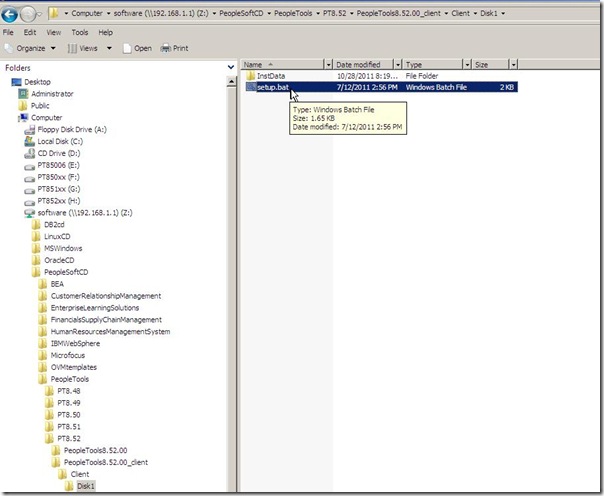

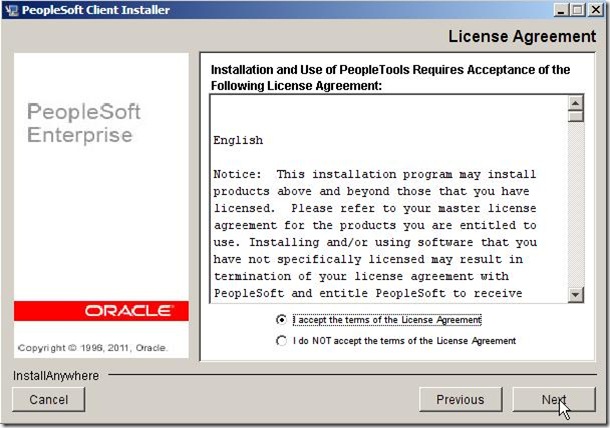
The license code is the same for the “standard” Peopletools install : 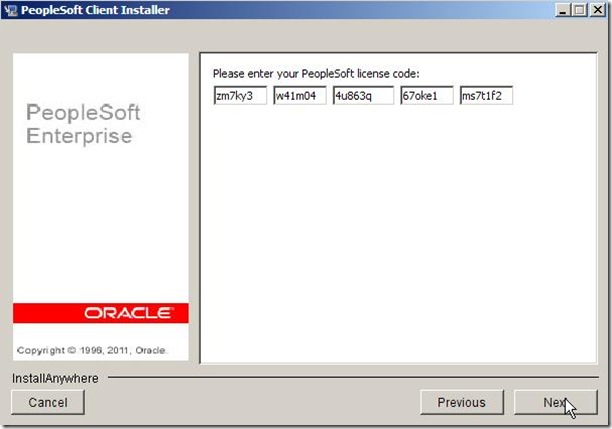
Usually, the Non-Unicode/Unicode type is for the data we are loading into the database, since it won’t install any of the loading scripts and data files, I’m wondering why the question is there and what it does exactly, but keep consistency with you whole environment:
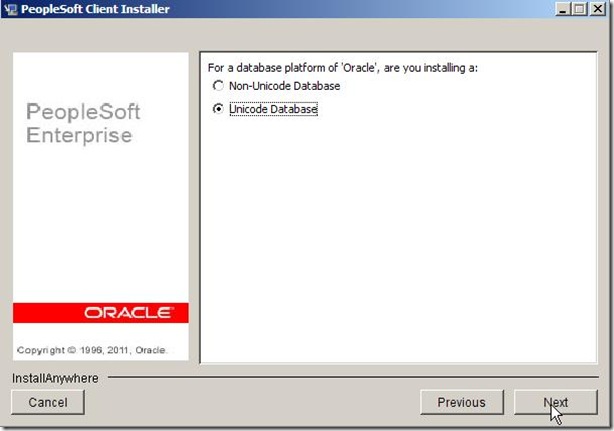
Choose a directory to install into : 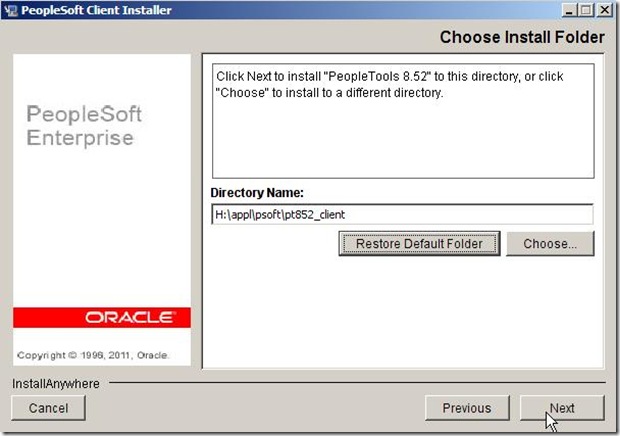
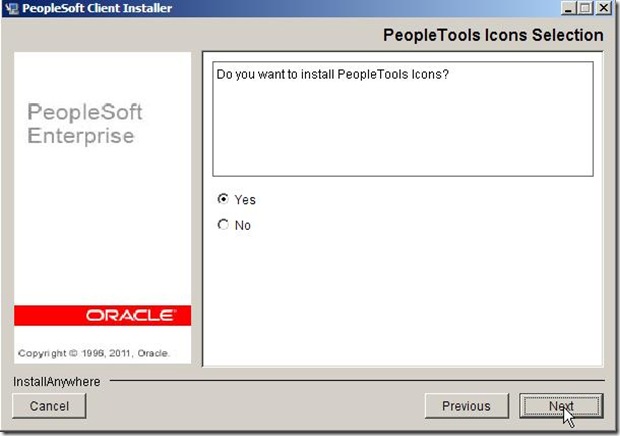
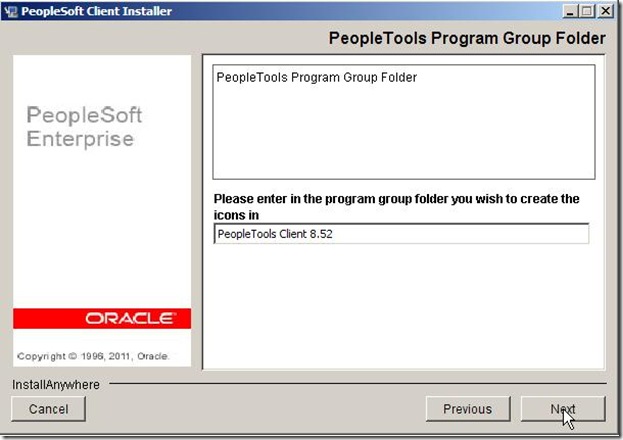
Here also I’m not sure to understand why the PSEMHUB is there, it is used by the PSEMAgent, but you probably don’t want to manage remotely the client installation, but again, here we go : 
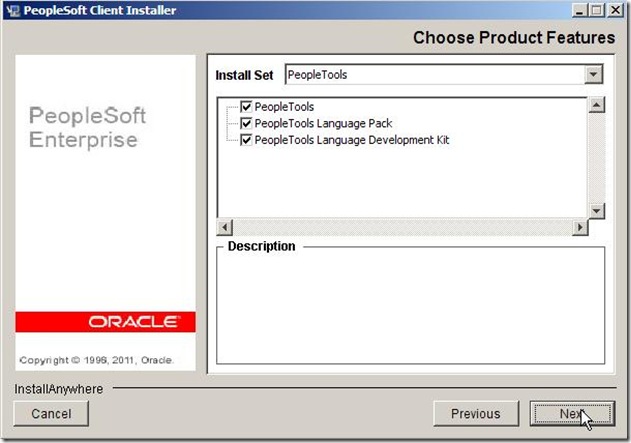
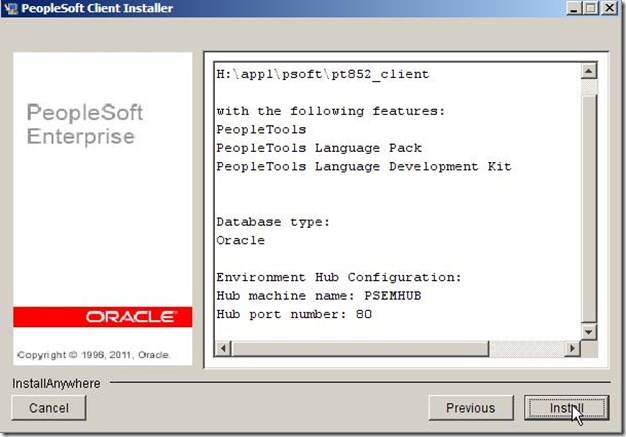
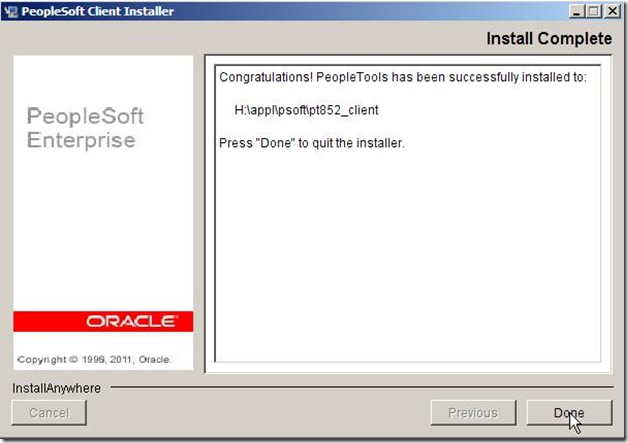
In the process above, that’s interesting to note the installer never prompt for the Oracle binaries (%ORACLE_HOME%\bin) like it is for the server Peopletools installation on Windows.
The client can also be patch with the latest Peopletools patch, since the patch 8.52.02 is already available, let’s apply it on that client. So far, there’s no patch dedicated to the client only installation, so the patch is twice bigger than the client installer… : 
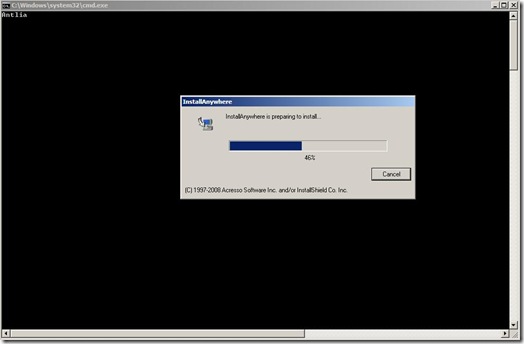
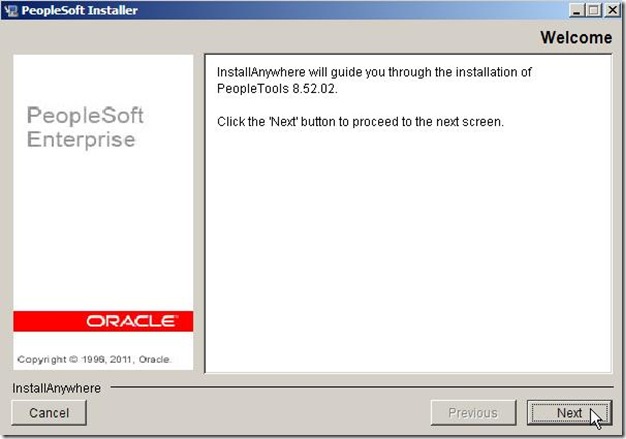

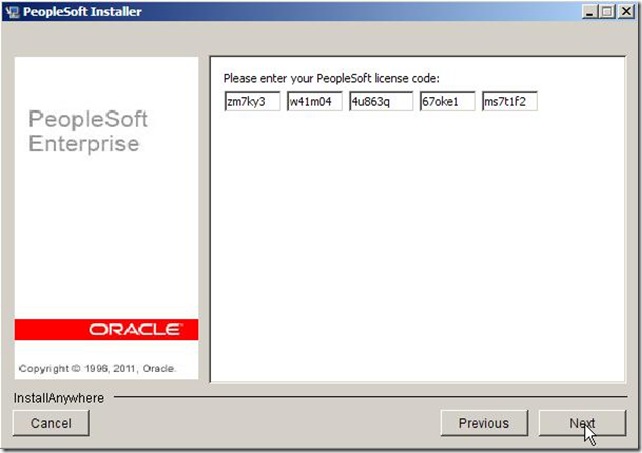
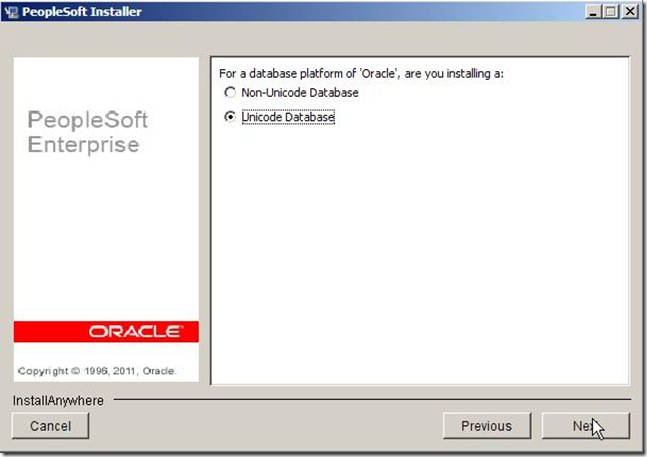
Here you decide what kind of installation you are doing. However, I’m not sure what will happen if you choose to patch a client and here below check “Full Install”. Is your client become a server ? It probably has to be tested. Let’s have a client only patch install : 
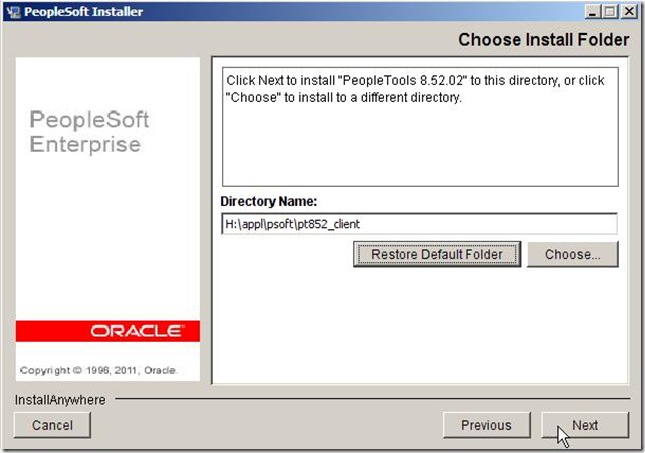
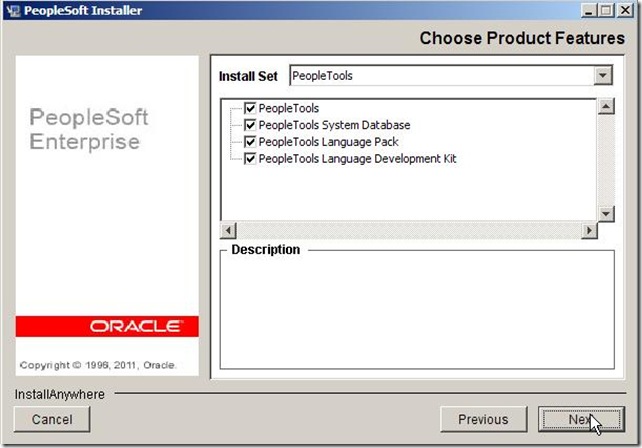
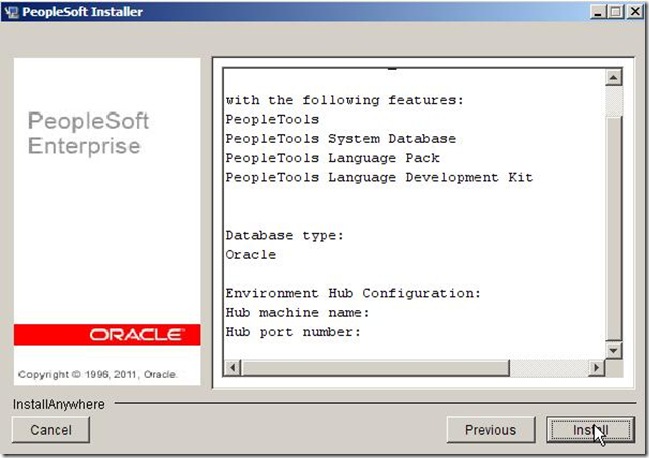

In the end of the process, here are the different folders present in the client home : 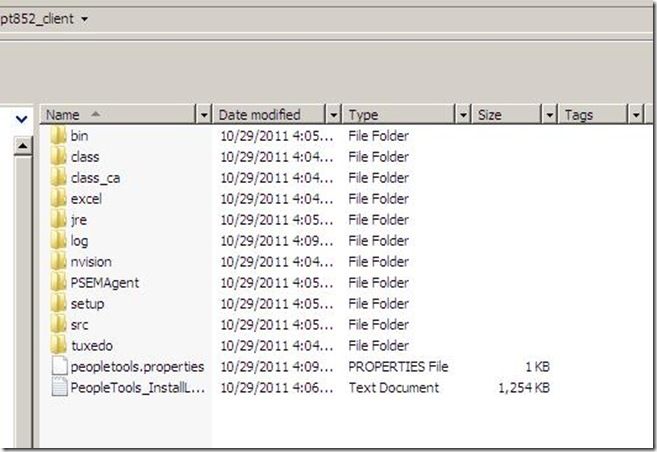
It’s really a light install, no script, no data. Should you load a database, do not use that installation, go for a full (or server) installation instead.
But that’s still good to have for developers’ local workstation installation.
***
You may receive the following error when launching AppDesigner and DataMover (“the application has failed to start because its side-by-side configuration is incorrect”) : 
In that case, run from the client home, \setup\psvccrt\psvccrt_retail.msi, and follow the instruction : 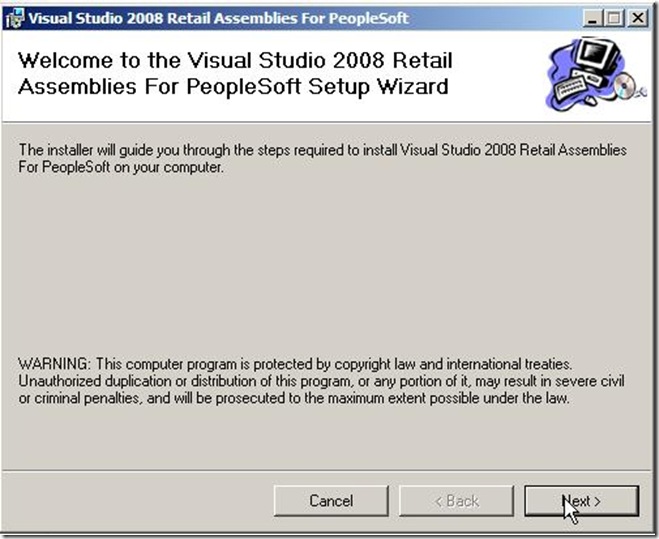
It should solve the problem, and you will be able to run AppDesigner and DataMover from now.
Last but not least, it is not certified on Windows XP, I tried it though. “Not certified” has never meant “not working”, so, whether the installer Disk1\setup.bat seems hanging forever, the exe file under “Disk1\InstData\setup.exe” run fine and Peopletools 8.52 is installing successfully on my Windows XP SP3 Pro workstation.
Nicolas.
Saturday, October 29, 2011
Peopletools patch 8.52.02 unzipping issue
Peoplesoft delivered the patch 02 of Peopletools 8.52. As usual, the patch is zipped and password protected. But that time, the password contains a “very” special character, I named exclamation mark (!).
Unzipping a file within a password on Unix/Linux is quite simple :
unzip –P password zipfile.zip
Now the given instruction is something like this :
unzip –P "pass!word" zipfile.zip
The double-quotes should make the command successful in most of the cases even with special characters.
But because of the exclamation mark, it won’t work. The following error is returned :
-bash: !word": event not found
I won’t give the password here (password is available on My Oracle Support only – paid support required), but just a workaround to get the patch unzipped. The instruction should be :
unzip -P "pass"'!'"word" zipfile.zip
Note the double-quote and simple-quote around the exclamation mark.
Probably that exception has been forgotten by Oracle people when building the zip file or when writing the documentation shipped with the patch.
Hope that helps,
Nicolas.
Friday, October 28, 2011
Peopletools 8.52 is released !
Available on edelivery, it is 3 disks (rather funny the 3rd is only 18M).
As previously announced no more WebSphere and COBOL software shipped within the Peopletools bundle.
A good surprise, a Windows client dedicated installer (Windows Client only - 598M, could make life easier on workstation).
Last but not least, so far none of the applications have been recut yet with the new Peopletools version, so be careful and do not forget to manage a Peopletools upgrade of your newly application installation within that Peopletools 8.52.
To be continued with the install,
Nicolas.
NB (28/10/2011 18:44 CET) : I was probably far too optimistic on patch, the “first” patch is now available, but not as 8.52.01, rather odd, but that’s 8.52.02, see ftp://ftp.peoplesoft.com/outgoing/ptools/85202/
NB (29/10/2011) : and here the announcement http://blogs.oracle.com/peopletools/entry/peopletools_8_52_is_generally
Thursday, October 20, 2011
OEM 12c
A new version of Oracle Enterprise Manager has been released sometime ago, the 12c !
The first thing I can say is regarding the Installer, it now includes all the requisites (well, except database). Weblogic is installed at the same time, no need anymore to look for it, which version, which patch as it was on previous version 11gr1.
The installation can really take a while depending of the network, but in the end it’s really nice : 
What a change compared to all the previous version ! And changes do not stop on the login page, it is rather disturbing to get all the new habits, but that’s just a matter of time…
Home page : 
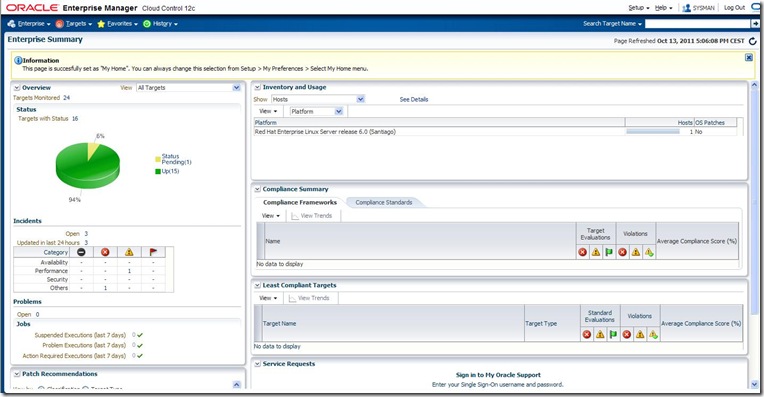
And here the databases list : 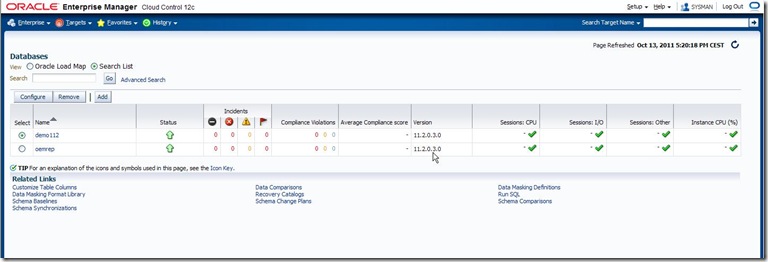
I don’t know yet how heavy it is in terms of resources on the server, but looks really nice.
Few things though :
1. no Peoplesoft plugin yet for that version
2. OEM12c Server Manager is only certified within Agent 12c… hopefully all your databases are running on OS which support it.
3. Surprising (for me), it is not yet certified on Linux 6.x
Enjoy it,
Nicolas.
Oracle 11.2.0.3 patchset
Sometime ago has been released the latest patchset, 11.2.0.3 (so far Linux only). Whether it is still not certified on Oracle Linux 6.x, it is working working fine.
Working in the same environment as I previously created here, Oracle Linux 6.0 and Oracle database 11.2.0.2, I’m doing an out-of-place upgrade.
The installer is complaining about missing RPMs… 
Installing the corresponding RPMs (and remove pdksh if already installed, replaced by ksh) :
[root@orion4:/mnt]# mount /dev/cdrom /mnt/cdrom
mount: block device /dev/sr0 is write-protected, mounting read-only
[root@orion4:/mnt]# cd /mnt/cdrom/
[root@orion4:/mnt/cdrom]# cd Packages/
[root@orion4:/mnt/cdrom/Packages]# rpm -Uvh compat-libcap1-1.10-1.x86_64.rpm
warning: compat-libcap1-1.10-1.x86_64.rpm: Header V3 RSA/SHA256 Signature, key ID ec551f03: NOKEY
Preparing... ########################################### [100%]
1:compat-libcap1 ########################################### [100%]
[root@orion4:/mnt/cdrom/Packages]# rpm -Uvh ksh-20100621-2.el6.x86_64.rpm
warning: ksh-20100621-2.el6.x86_64.rpm: Header V3 RSA/SHA256 Signature, key ID ec551f03: NOKEY
error: Failed dependencies:
pdksh conflicts with ksh-20100621-2.el6.x86_64
[root@orion4:/mnt/cdrom/Packages]# rpm -e pdksh
[root@orion4:/mnt/cdrom/Packages]# rpm -Uvh ksh-20100621-2.el6.x86_64.rpm
warning: ksh-20100621-2.el6.x86_64.rpm: Header V3 RSA/SHA256 Signature, key ID ec551f03: NOKEY
Preparing... ########################################### [100%]
1:ksh ########################################### [100%]
[root@orion4:/mnt/cdrom/Packages]#
[root@orion4:/mnt/cdrom/Packages]# cd /
[root@orion4:/]# umount /dev/cdrom
[root@orion4:/]#
Then check again and it’s going smoothly : 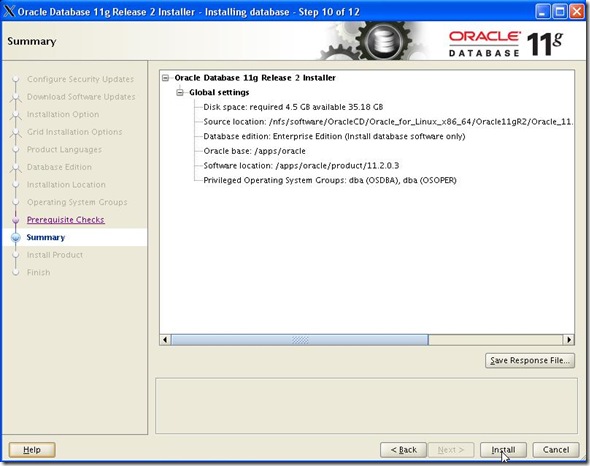
… 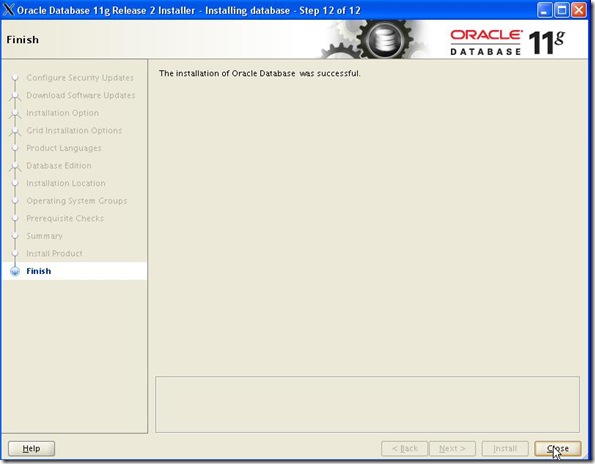
After changing the ORACLE_HOME setting of oracle user (OS user), upgrading the database successfully as well : 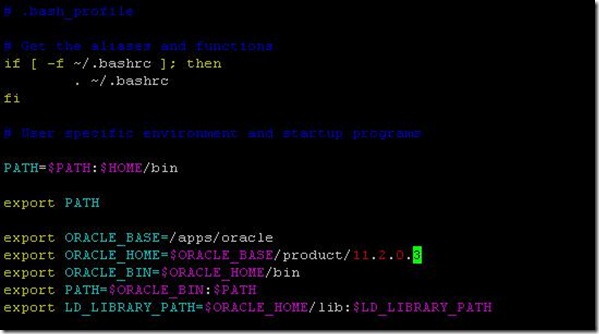
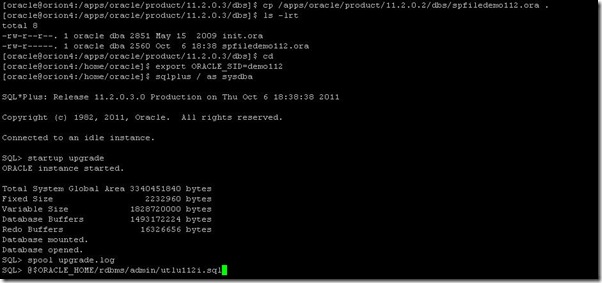
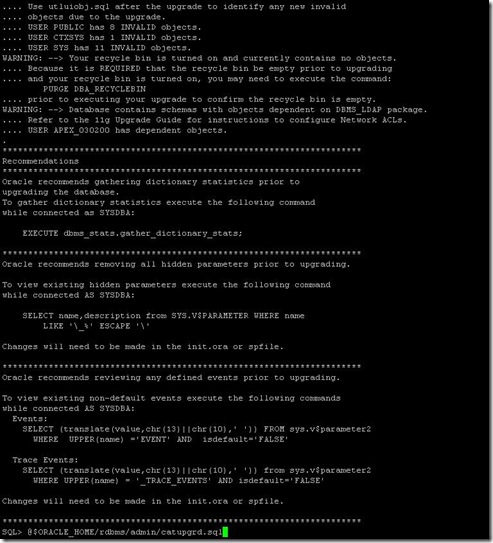
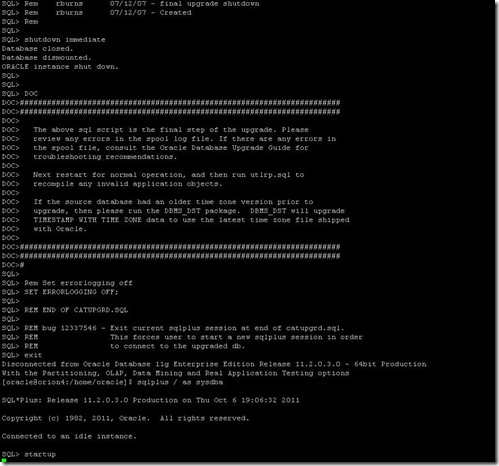
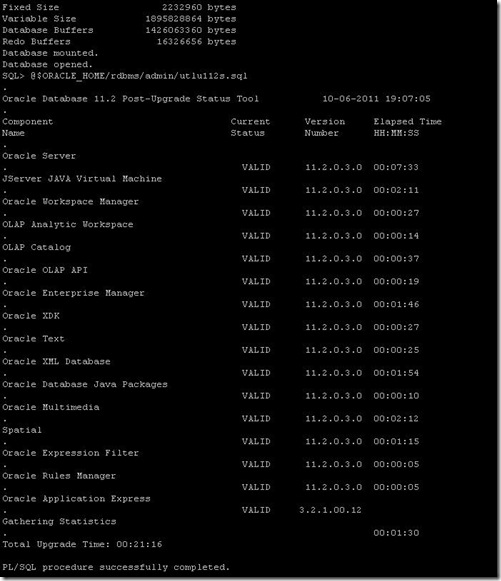
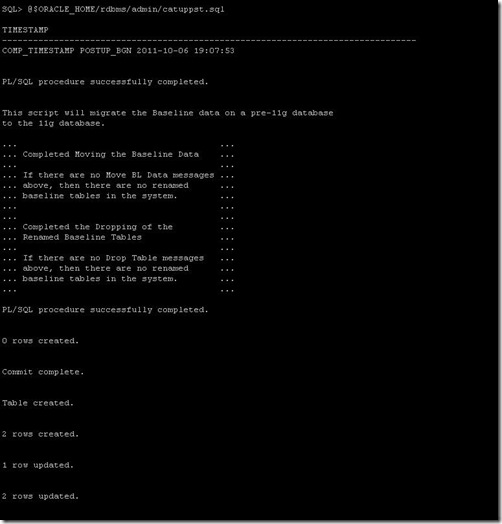
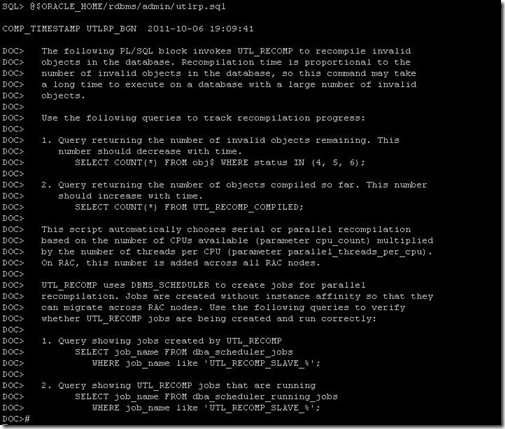
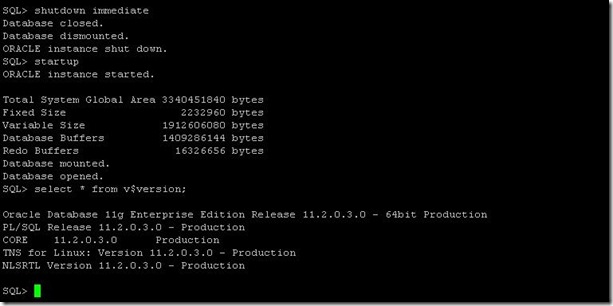
You can see the new features coming within this patchset in the on-line documentation.
Enjoy,
Nicolas.
Thursday, October 13, 2011
Peopletools 8.52 : get your infrastructure ready
It has been discussed several times during the last Oracle Open World 2-6 oct. 2011, Peopletools 8.52 is just next to the door. It seems this version will change a lot of things, see the pre-release notes #1335812.1 and the value proposition #1327656.1.
But in order to be able to run this Peopletools 8.52 version, the infrastructure needs to be up to dated. There’re indeed a couples of changes and decommissioned platforms on server as well as client side which may imply some work in front.
Starting by the client :
Up to Peopletools 8.51, Windows XP Pro (32bit) was certified and worked fine as a client for AppDesigner for developers. It is now ended. Not sure if it will work, but it is not planned to be certified. I know, Windows XP is quite an old OS, but still widely used. Client must be now on Windows 7, Vista (who really wants it by now ?), or Windows 2008 (honestly, I don’t know many workstation on that version). Keep in mind to verify the edition.
Speaking on client side, browsing is also changing a lot, a very new nice one, Apple iPad (browser Safari) will be certified ! And finally, Peoplesoft is introducing certification of Google Chrome.
On server side :
OS: HP-UX PA-RISC certification is now definitely ended, AIX 5.3 is also ended (7.1 added).
Surprisingly, Oracle Linux 6.x is not planned to be certified (right, Oracle database is not certified yet on this Linux version), but I tend to think it will be certified soon too.
Database : Oracle 11.2.0.2, 11.1.0.7 and 10.2.0.5 (10.2.0.4 and earlier is ended), probably the newly released 11.2.0.3 patchset will also be certified soon (not planned yet).
Applications : they must be 8.9 or above, whereas Peopletools 8.51 was certified from within applications 8.8.
WebSphere : keep in mind, that within Peopletools 8.52, WebSphere won’t be provide anymore, support must be obtained from IBM to get the software.
COBOL compiler : similarly to the above, Peopletools 8.52 won’t come anymore with a compiler, support must be obtained from the vendor (not only Microfocus, but also IBM).
Regarding these last two points, please read this roadmap.
Except that Peopletools 8.50 was certified on x64 architecture only, I don’t think there were so many changes on the previous 8.5x versions.
So, if you want the coming soon Peopletools 8.52 and are in one of the ended certifications as describe above, prepare your infrastructure for a change. Or if that’s for demo, proof of concept and/or training purpose, you can always wait for the associated Oracle VM Peoplesoft templates (well, that supposes you have a spare server in a corner for hosting Oracle VM… that’s an other story), but not sure how long it will take to be available.
All these changes could be quite problematic if you have to deal with much older Peopletools release and Application version… which require different OS on server but also on client side (Peopletools 8.48 and earlier are not certified on Windows 7).
Administration tasks :
Few administration tasks may also change.
New variable : this could have an impact on your architecture as well, in Peopletools 8.50 has been introduced a new environment variable, PS_CFG_HOME to decouple the application/batch domain from the PS_HOME. A new one is coming within Peopletools 8.52 to separate the application installation home from the Peopletools installation home, PS_APP_HOME. It often confused new-comers in Peoplesoft world, why the application must be installed in the same folder as the Peopletools, now it is finished, we could install application where ever we want using that variable, and have multiple applications pointing to a unique Peopletools home directory.
PSADMIN menu : new options to manage the PIA such as create, clone, delete, check status…
Active DataGuard : I hope also Peoplesoft be more integrated within Active Data Guard, as I showed in an earlier blog entry there’s no Crystal, COBOL and SQR on a standby database supported. But I’m quite disappointed, it does not appear to be in the pre-release notes linked above.
This Peopletools 8.52 will change a lot of things, here was a non-exhaustive list on admin side, but there’s much more.
I’m really looking forward that new version.
Enjoy,
Nicolas.
PS: please note that this blog entry is based on “pre-release” notes and current certification matrix as of today – 13-OCT-2011, so it may change…
Friday, September 30, 2011
Application server load balancing and failover
In a previous blog’s entry, I explained about Multiple application messaging servers on Peopletools 8.51 and facilities for load balance and failover on messaging domain server.
In a very similar way, the application server can also be used in load balance and failover configuration.
First of all, you need at least two applications servers, please note that if you are on the same server, then domain name and JSL (jolt) port should be different from each other. Of course, there are not many advantages to have this configuration if working on one and only one server, but rather good to have different server, if one crash, the other one takes place.
Here we go.
First application server : 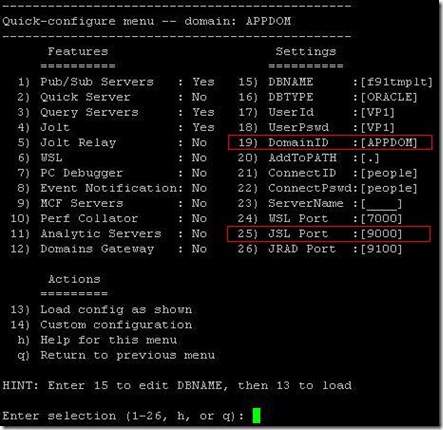
And the second one : 
Please, note that whether I name one “first” and the other one “second”, there is no precedence of one compared to the other by default (except if you define a weight in configuration.properties, but let’s leave it for later explanation).
Then starting each application server 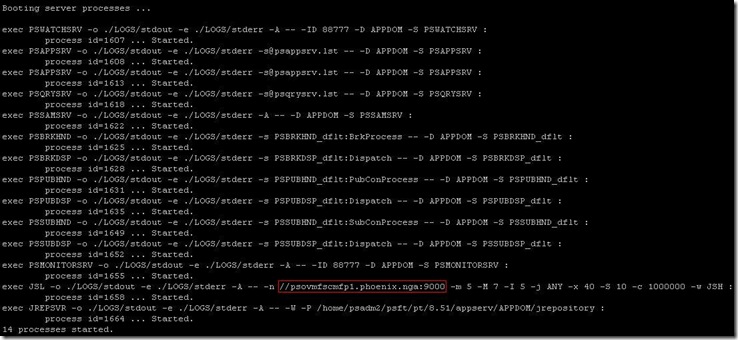
Note that the number of listened ports regarding Jolt is defined is the psappsrv.cfg of the domain as following :
[JOLT Listener]
;=========================================================================
; Settings for JOLT Listener
;=========================================================================
Address=%PS_MACH%
Port=9000
Encryption=0
Min Handlers=5
Max Handlers=7
In the current case, the ports between 9000 and 9005 will be immediately in use after started :
[psadm2@psovmfscmfp1 APPDOM]$ netstat -an|grep 900
tcp 0 0 192.168.1.150:9000 0.0.0.0:* LISTEN
tcp 0 0 192.168.1.150:9001 0.0.0.0:* LISTEN
tcp 0 0 192.168.1.150:9002 0.0.0.0:* LISTEN
tcp 0 0 192.168.1.150:9003 0.0.0.0:* LISTEN
tcp 0 0 192.168.1.150:9004 0.0.0.0:* LISTEN
tcp 0 0 192.168.1.150:9005 0.0.0.0:* LISTEN
[psadm2@psovmfscmfp1 APPDOM]$
It means the second domain needs to be configured with a port above 9005. 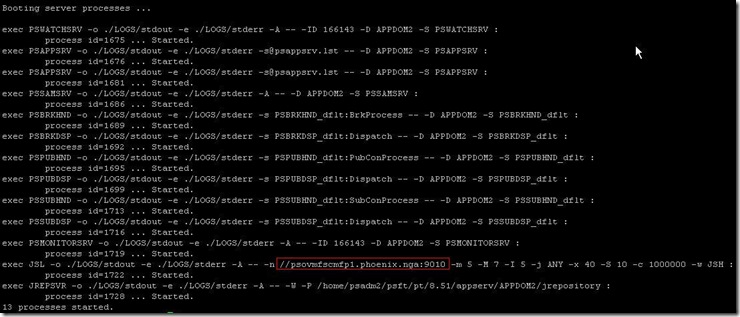
Here’s the output from the database side, since my two apps are on the same machine, there’s nothing really useful so far, cannot distinguished which domain a database session is coming from :
SQL> select username,program, client_info from v$session where username = 'SYSADM'
SQL> /
USERNAME PROGRAM CLIENT_INFO
------------------------------ ------------------------------------------------ ----------------------------------------------------------------
SYSADM PSSUBDSP@psovmfscmfp1.phoenix.nga (TNS V1-V3) VP1,psadm2,psovmfscmfp1.phoenix.nga,,PSSUBDSP,
SYSADM PSSUBHND@psovmfscmfp1.phoenix.nga (TNS V1-V3) VP1,psadm2,psovmfscmfp1.phoenix.nga,,PSSUBHND,
SYSADM PSPUBDSP@psovmfscmfp1.phoenix.nga (TNS V1-V3) VP1,psadm2,psovmfscmfp1.phoenix.nga,,PSPUBDSP,
SYSADM PSBRKDSP@psovmfscmfp1.phoenix.nga (TNS V1-V3) VP1,psadm2,psovmfscmfp1.phoenix.nga,,PSBRKDSP,
SYSADM PSPUBHND@psovmfscmfp1.phoenix.nga (TNS V1-V3) VP1,psadm2,psovmfscmfp1.phoenix.nga,,PSPUBHND,
SYSADM PSBRKHND@psovmfscmfp1.phoenix.nga (TNS V1-V3) VP1,psadm2,psovmfscmfp1.phoenix.nga,,PSBRKHND,
SYSADM PSSAMSRV@psovmfscmfp1.phoenix.nga (TNS V1-V3) VP1,psadm2,psovmfscmfp1.phoenix.nga,,PSSAMSRV,
SYSADM PSQRYSRV@psovmfscmfp1.phoenix.nga (TNS V1-V3) VP1,psadm2,psovmfscmfp1.phoenix.nga,,PSQRYSRV,
SYSADM PSAPPSRV@psovmfscmfp1.phoenix.nga (TNS V1-V3) VP1,psadm2,psovmfscmfp1.phoenix.nga,,PSAPPSRV,
SYSADM PSAPPSRV@psovmfscmfp1.phoenix.nga (TNS V1-V3) VP1,psadm2,psovmfscmfp1.phoenix.nga,,PSAPPSRV,
SYSADM PSMONITORSRV@psovmfscmfp1.phoenix.nga (TNS V1-V3 VP1,psadm2,psovmfscmfp1.phoenix.nga,,PSMONITORSRV,
SYSADM PSSUBDSP@psovmfscmfp1.phoenix.nga (TNS V1-V3) VP1,psadm2,psovmfscmfp1.phoenix.nga,,PSSUBDSP,
SYSADM PSSUBHND@psovmfscmfp1.phoenix.nga (TNS V1-V3) VP1,psadm2,psovmfscmfp1.phoenix.nga,,PSSUBHND,
SYSADM PSPUBDSP@psovmfscmfp1.phoenix.nga (TNS V1-V3) VP1,psadm2,psovmfscmfp1.phoenix.nga,,PSPUBDSP,
SYSADM PSPUBHND@psovmfscmfp1.phoenix.nga (TNS V1-V3) VP1,psadm2,psovmfscmfp1.phoenix.nga,,PSPUBHND,
SYSADM PSBRKDSP@psovmfscmfp1.phoenix.nga (TNS V1-V3) VP1,psadm2,psovmfscmfp1.phoenix.nga,,PSBRKDSP,
SYSADM PSMONITORSRV@psovmfscmfp1.phoenix.nga (TNS V1-V3 VP1,psadm2,psovmfscmfp1.phoenix.nga,,PSMONITORSRV,
SYSADM PSBRKHND@psovmfscmfp1.phoenix.nga (TNS V1-V3) VP1,psadm2,psovmfscmfp1.phoenix.nga,,PSBRKHND,
SYSADM PSAPPSRV@psovmfscmfp1.phoenix.nga (TNS V1-V3) VP1,psadm2,psovmfscmfp1.phoenix.nga,,PSAPPSRV,
SYSADM PSSAMSRV@psovmfscmfp1.phoenix.nga (TNS V1-V3) VP1,psadm2,psovmfscmfp1.phoenix.nga,,PSSAMSRV,
SYSADM PSAPPSRV@psovmfscmfp1.phoenix.nga (TNS V1-V3) VP1,psadm2,psovmfscmfp1.phoenix.nga,,PSAPPSRV,
21 rows selected.
Now, webserver configuration to be done in configuration.properties file ($PS_HOME/webserv/peoplesoft//applications/peoplesoft/PORTAL.war/WEB-INF/psftdocs/ps).
This is a easy configuration, put the application servers separated by simple comma as following :
[psadm2@psovmfscmfp1 peoplesoft]$ more ./applications/peoplesoft/PORTAL.war/WEB-INF/psftdocs/ps/configuration.properties
<<...snipped...>>
# psserver must point to your application server machine name (recommended) or IP address
# and JOLT port. The PeopleTools release of the application server must match the PeopleTools
# release of the PeopleSoft files on the web server.
#
# To enable jolt failover and load balancing, provide a list of application server
# domains in the format of; psserver=AppSrvr:JSLport,...
# For example: psserver=SERVER1:9000,SERVER2:9010,SERVER3:9020
## sd="Application Server Connect String", ld="This string embodies the failover and load balancing string for PIA to connect to Application Server domains. Consult the PeopleB
ooks recommendations on load balancing and failover for more information. The format is psserver=AppSrvr:JSLport where AppSrvr is your fully qualified domain name. Multiple d
omains should be comma separated", tip="Format: psserver=AppSrvr:JSLport where AppSrvr is your fully qualified domain name, e.g psserver=SERVER1.oracle.com:9000,SERVER2.oracle.
com:9010"
psserver=psovmfscmfp1:9000,psovmfscmfp1:9010
## sd="Jolt Pooling", dt="c", ld="Enable Jolt Pooling"
joltPooling=true
<<...snipped...>>
Configured as above, all the application servers have the same weight (the same priority) in the round-robin algorithm. This algorithm affect ingoing transaction randomly to one or the other configured application server, there’s no priority, no load checkup, no network checkup, it’s just random (find out more in the My Oracle Support note E-WS: Load Balancing Options for Web Server and Application Server [ID 618367.1]).
But we could also introduced weight (from 1 to 10) on application server to make one precedence on the other as following :
psserver=psovmfscmfp1:9000#10,psovmfscmfp1:9010#1
In that case, the first server can takes extra work for an heavy load compared to the second one.
Not only the load balance will be set, but the failover as well.
After the first connection to the front end application, we can check the client status of both application servers : 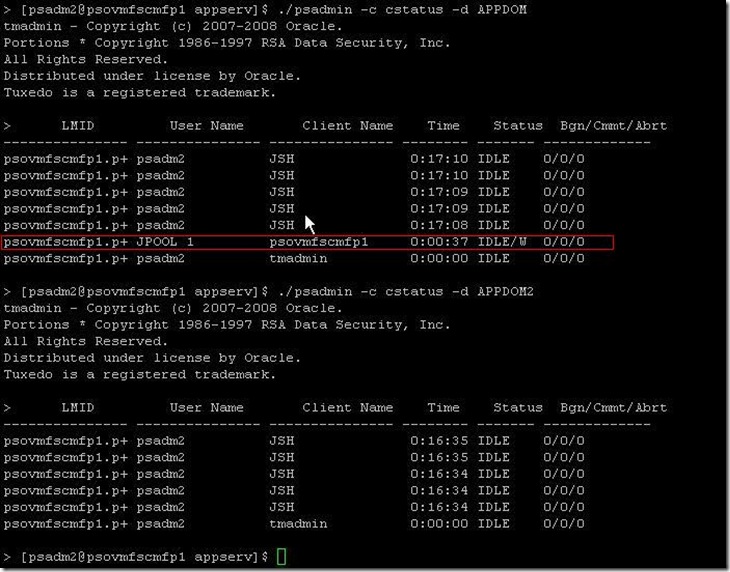
We can see a first pool as been instantiated.
Since round-robin algorithm is randomly given connection to the application server, it’s not always easy to show when alone, furthermore, the pool connection are making it even less simple.
But you probably can check it from the back end :
SQL> select username,program, client_info from v$session where username = 'SYSADM'
2* order by 2
SQL> /
USERNAME PROGRAM CLIENT_INFO
------------------------------ ------------------------------------------------ ----------------------------------------------------------------
SYSADM PSAPPSRV@psovmfscmfp1.phoenix.nga (TNS V1-V3) NGA,,192.168.1.202,APPDOM,PSAPPSRV,
SYSADM PSAPPSRV@psovmfscmfp1.phoenix.nga (TNS V1-V3) VP1,,192.168.1.202,APPDOM2,PSAPPSRV,
SYSADM PSAPPSRV@psovmfscmfp1.phoenix.nga (TNS V1-V3) NGA,,192.168.1.202,APPDOM,PSAPPSRV,
SYSADM PSAPPSRV@psovmfscmfp1.phoenix.nga (TNS V1-V3) VP1,,192.168.1.202,APPDOM2,PSAPPSRV,
…
Here, from the same client machine, different users are in connected through the 2 applications servers (APPDOM and APPDOM2).
Now, let’s simulate a application server crash : 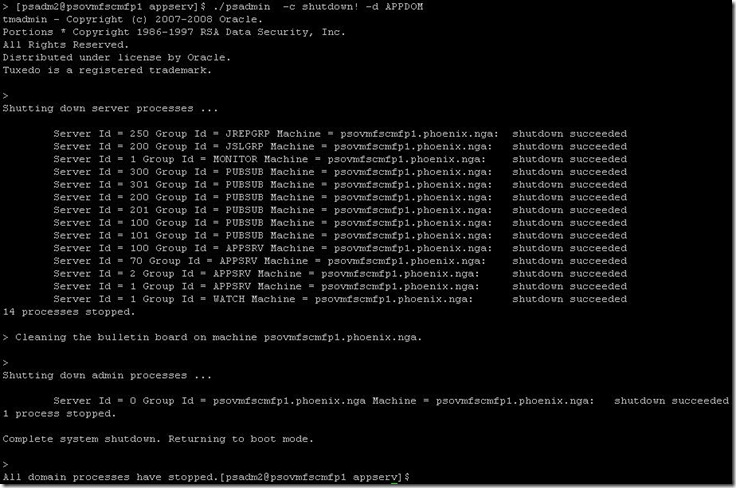
The online users won’t be disconnected, and the opened connections are automatically redirected to the second application server (failover) : 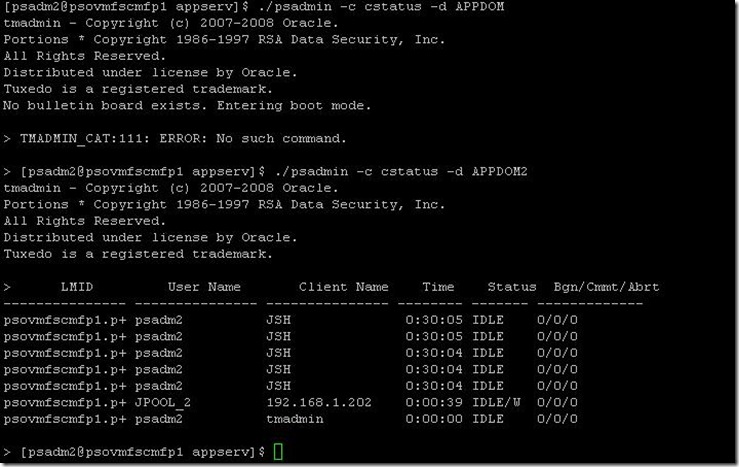
A second pool is now created, but that one on APPDOM2. Everything will be transparent to the front end users.
Find out more in the OTN hosted Peoplebooks : Working with Jolt Configuration Options
Nicolas.
PS: whilst I was writing this blog entry, I was reading an interesting note as well recommending the use of IP address instead of the server name for security reason in the configuration.properties (worth reading it Health Check Alert: Consider setting PSSERVER for web server JOLT connections to refer to an IP-address:port combination [ID 957484.1]).
